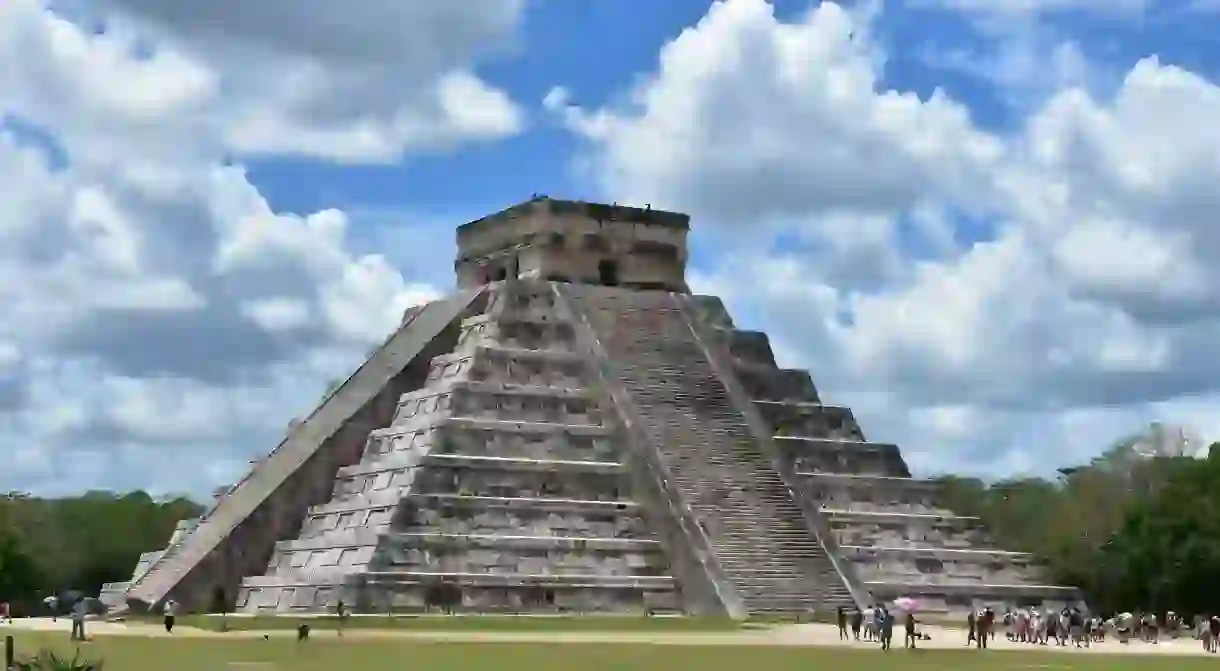The 10 Best Mayan Sites to Visit Near Mérida, Mexico

Marvel at the ancient Mayan pyramids and temples, bathe in adjoining cenotes and walk through scenic jungle-trailed settings on day trips from the Yucatán state capital.
As the capital of Mexico’s Yucatán state, Mérida is a city forged from Spanish colonial riches with a history deeply rooted in the Mayan people who still inhabit it. It was their ancestors, after all, who built one of the most impressive societies of ancient times, and testimony to their advanced civilization can still be found scattered around the surrounding landscape. Mérida aptly makes the perfect base for exploring these fascinating sites. Whether lingering at one or squeezing several into a day, here’s a rundown of the best.
Chichén Itzá
Archaeological site

An hour and half from Mérida, the mighty pyramid-shaped Temple of Kukulcán, also known as El Castillo, at Chichén Itzá is the most recognizable of all Mayan structures, thanks to its impressive size, extraordinary details and painstaking restoration. This sophisticated spiritual and urban center also boasts a particularly fine Mayan ball court, as well as a series of plazas and an observatory. During spring and fall equinoxes, the northwest corner of El Castillo casts a shadow that mimics a snake slithering down the pyramid. Nightly light and sound shows also tell the story of the ancient Maya.
Dzibilchaltún
Ruins, Historical Landmark
Uxmal
Historical Landmark

Xlapak
Ruins, Historical Landmark
Close to Labna and another stop on the Puuc Route, Xlapak is a modest-sized archeological site set among a pretty sylvan setting. Meaning “old walls”, the complex features wonderful examples of carved stone facades and stacked representations of Chaac, the Mayan god of rain. It’s more a lovely walk dotted with impressive, though low-key, Mayan ruins, so most won’t do the four-hour round trip for this site alone. Better to tag it on to a visit to Uxmal or Labna – both a 40-minute hop from here.
Cobá
Ruins, Historical Landmark

Labna
Archaeological site, Ruins, Historical Landmark
The once-ceremonial center of Labna can be found in the Puuc Hills and is one of several smaller sites you can fit into a day-trip dubbed the Puuc Route. It’s still certainly worth a visit on its own merits, however, with its intimate and uncrowded (sometimes empty) setting that really helps you to step back in time. The site is best known for the Labna Arch, a handsomely symmetrical structure with an ornately carved frieze. The El Mirador pyramid, topped with a precarious-looking temple structure, has also miraculously defied the passing centuries.
Ek Balam
Ruins, Historical Landmark

Kabah
Ruins, Historical Landmark
The second-largest site in the Puuc region after Uxmal, Kabah is most remarkable for its 11mi (18km) ceremonial causeway with stone arches at either end. Also mightily impressive is the Palace of the Masks, with a long lengthy façade decorated with hundreds of ornate stone masks referencing rain god, Chaac. Incense has even been discovered in some of the long stone noses of the rain god’s masks.
Sayil
Historical Landmark, Ruins
To complete the Puuc Route, a trip to the ruins of Sayil is a must. This Classic Maya site peaked in the 10th century, and left behind up to 10,000 structures over several square miles. The Great Palace is its most complete and impressive, stretching almost 300ft (85m) across three levels. Jungle trails connect the various areas, and an absence of crowds means you can really lose yourself in it all.
Trips and Tours in Mexico
Architectural Landmark

Planning a visit to the beautiful country of Mexico? If you’re keen to see as many of the incredible sites on this list as you can, you’re best off booking a multi-day tour that shows you the very best this country has to offer.
Find the perfect base for exploring Mérida by booking your hotel via Culture Trip. For more things to do in the Yucatán’s cultural capital, browse the best restaurants in the city. Explore the rest of the Yucatán by checking out the most beautiful destinations on the peninsula. Book your stay in nearby Campeche for a taste of what else the area has to offer, or venture further out to Cancún and stop by the city’s best markets.
This article is an update of one originally by Stephen Woodward.













